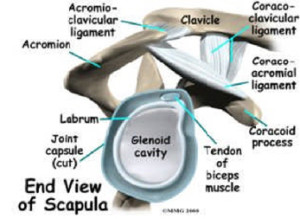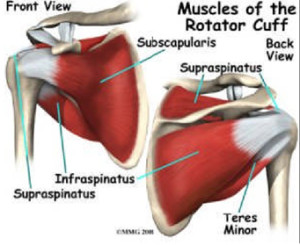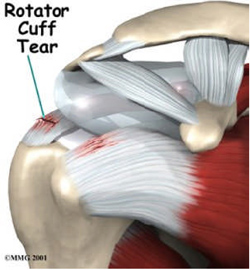Rotator Cuff
Overview
The shoulder is a dynamic and complex piece of machinery. Its design allows us to reach and use our hands in many different positions. However, the trade off for the shoulder joint’s great range of motion, is that it is not very stable. This makes the shoulder vulnerable to problems if any of its parts

Bones of the Shoulder
aren’t in good working order. The rotator cuff tendons are integral to the healthy functioning of the shoulder. They are subject to a lot of wear and tear, or degeneration, as we use our arms. Tearing of the rotator cuff tendons is an especially painful injury. A torn rotator cuff creates a very weak shoulder. Most of the time patients with torn rotator cuffs are in late middle age. But rotator cuffs tears can happen at any age.
Anatomy: What exactly is the rotator cuff, and what does it do?
The shoulder is made up of three bones: the scapula(shoulder blade), the humerus (upper arm bone), and the clavicle (collarbone).

Scapula End View
The upper part of the scapula that makes up the roof of the shoulder is called the acromion.

Bursa
A bursa is located between the acromion and the rotator cuff tendons. A bursa is a lubricated sac of tissue that cuts down on the friction between two moving parts. Bursae are located all over the body where tissues must rub against each other. In this case, the bursa protects the acromion and the rotator cuff from grinding against each other.

Rotator Cuff Muscles
The rotator cuff connects the humerus to the scapula. The rotator cuff is formed by the tendons of four muscles: the supraspinatus, infraspinatus, teres minor, and subscapularis.
Tendons attach muscles to bones. Muscles move the bones by pulling on the tendons. The rotator cuff helps raise and rotate the arm. As the arm is raised, the rotator cuff also keeps the humerus tightly in the socket of the scapula.
Causes: What causes the rotator cuff to become inflamed and/or tear?

Rotator Cuff Tear
The rotator cuff tendons have areas of very low blood supply. The more blood supply a tissue has, the better and faster it can repair and maintain itself. The areas of poor blood supply in the rotator cuff make these tendons especially vulnerable to degeneration from aging. This degeneration of aging helps explain why the rotator cuff tear is such a common injury later in life.- Degeneration may be accelerated by repeating the same types of shoulder motions. This can happen with overhand athletes, such as baseball pitchers, but even doing routine chores like cleaning mirrors, washing and waxing a car, or painting can cause the rotator cuff to fatigue from overuse.
- Excessive force can tear weak rotator cuff tendons. This force can come from trying to catch a heavy falling object or lifting an extremely heavy object with the arm extended. The force can also be from a fall directly onto the shoulder. Sometimes injuries that tear the rotator cuff are painful, sometimes they aren’t.
- The typical patient with a rotator cuff tear is in late middle age and has had problems with the shoulder for some time. This patient then lifts a load or suffers an injury that tears the tendon. After the injury, the patient is unable to raise the arm. However, these injuries also occur in young people. Overuse or injury at any age can cause rotator cuff tears.
Symptoms: What does a rotator cuff tear feel like?
- Rotator cuff tears cause pain and weakness in the affected shoulder. In some cases, a rotator cuff may tear only partially. The shoulder may be painful, but you can still move the arm in a normal range of motion. In general, the larger the tear, the more weakness it causes.
- In other cases, the rotator cuff tendons completely rupture. A complete tear makes it impossible to move the arm in a normal range of motion. It is usually impossible to raise the arm away from your side by yourself.
- Most rotator cuff tears cause a vague pain in the shoulder area. They may also cause a “catching” sensation when you move your arm. Most people say they can’t sleep on the affected side due to the pain.
Diagnosis & Treatment: What tests/treatments will my doctor utilize?
History & Exam
Your doctor will ask questions about your medical history, your injury, and your pain. Your doctor will then do a physical examination of the shoulder. The physical exam is most helpful in diagnosing a rotator cuff tear.
A complete tear is usually very obvious.
Imaging
You may want to do an arthrogram, which involves injecting dye into the shoulder joint and taking several X-rays and/or an MRI scan, a special imaging test that uses magnetic waves to create pictures of the shoulder in slices. The MRI scan shows tendons as well as bones.
Conservative Treatment
By diminishing the inflammation, further strengthening and stretching exercises can be performed Stretching of the shoulder rotator cuff muscles is easily performed both as treatment for inflammation and as a warm up before activity. Specific stretches are targeted to the desired activity any any shoulder stretches are available and most are helpful as long as sharp pain is avoided. The doctors will use electric stimulation, ultrasound, myofascial release, Graston Technique, manipulation, either combined or separately, depending on the individual case. Strengthening of the shoulder rotator cuff muscles is best performed by isolating each muscle group and selectively training that muscle. Shoulder exercises are best performed with relatively light weights and multiple repetitions, your doctor will set up a program specifically for you.
The logic behind stretching and strengthening the inflamed rotator cuff in order to speed healing and functional performance is as follows: the inflamed tissue is characterized by increased fluid between the cells, increased numbers of new blood vessels and inflammatory type cells. As a result of this inflammatory reaction, new collagen tissue is laid down in an effort by the body to heal the injured tissue. If the shoulder is immobilized during this time, the new collagen is laid down in a disorganized fashion, creating scar. The goal of stretching and strengthening is to stimulate the cells to lay down collagen along the lines of stress, forming normal strong tendons. The combination of a good warm up, gentle stretching, strengthening below the limits of pain, icing after working out has been consistently shown to speed recovery time in the strongest possible fashion.
Prevention
Shoulder injuries can be diminished by careful warm-up, stretching, and strengthening of the shoulder muscles. The exercises described above for treatment of the injured shoulder are superb for a general conditioning program. When shoulder injury symptoms begin, early evaluation and treatment can prevent mild inflammation from becoming full blown rotator cuff impingement, or worse, a tear of the rotator cuff. A program of twenty minutes a day of shoulder stretches and muscle strengthening exercises is recommended to increase performance and decrease injuries.